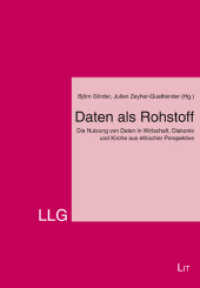- ホーム
- > 洋書
- > 英文書
- > Science / Mathematics
Full Description
The fundamental understanding of the production of biological effects by ionizing radiation may well be one of the most important scientific objectives of mankind; such understanding could lead to the effective and safe utilization of the nuclear energy option. In addition, this knowledge will be of immense value in such diverse fields as radiation therapy and diagnosis and in the space program. To achieve the above stated objective, the U. S. Department of Energy (DOE) and its predecessors embarked upon a fundamental interdisciplinary research program some 35 years ago. A critical component of this program is the Radiological and Chemical Physics Program (RCPP). When the RCPP was established, there was very little basic knowledge in the fields of physics, chemistry, and biology that could be directly applied to understanding the effects of radiation on biological systems. Progress of the RCPP program in its first 15 years was documented in the proceedings of a conference held at Airlie, Virginia, in 1972. At this conference, it was clear that considerable progr:ess had been made in research on the physical and chemical processes in well-characterized systems that could be used to understand biological effects. During this period of time, most physical knowledge was obtained for the gas phase because the technology and instru mentation had not progressed to the point that measurements could be made in liquids more characteristic of biological materials.
Contents
to the Problem.- The Molecular Biology of Radiation Carcinogenesis.- Radiological Physics.- Atomic and Molecular Theory.- Atomic and Molecular Physics in the Gas Phase.- Radiation Interactions and Energy Transport in the Condensed Phase.- Charged Particle Transport in the Condensed Phase.- Radial Distribution of Dose.- Early Chemical Events.- Radiation Interactions in High-Pressure Gases.- Energy Transfer, Charge Transfer, and Proton Transfer in Molecular Composite Systems.- Early Chemical Events and Initial DNA Damage.- The Chemistry of Free-Radical-Mediated DNA Damage.- Models of Radiation Effects.- The Radiological Significance of Spatial and Temporal Distribution of Energy Absorbed from Ionizing Radiation.- Phenomenological Models.- Mechanistic Models.- Carcinogenesis Models: An Overview.- Molecular Radiation Biology.- DNA Damage and Repair.- Structure-Function Relations in Radiation Damaged DNA.- Chemical, Molecular Biology, and Genetic Techniques for Correlating DNA Base Damage Induced by Ionizing Radiation with Biological End Points.- Exciton Microscopy and Reaction Kinetics in Restricted Spaces.- Summary.- Participants.








